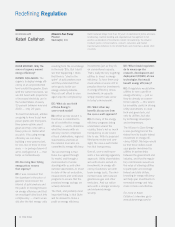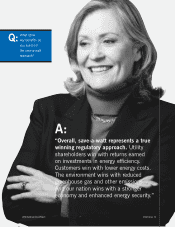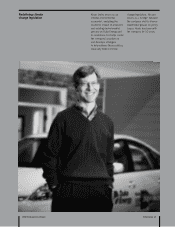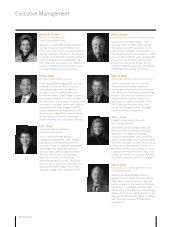Duke Energy 2008 Annual Report Download - page 22
Download and view the complete annual report
Please find page 22 of the 2008 Duke Energy annual report below. You can navigate through the pages in the report by either clicking on the pages listed below, or by using the keyword search tool below to find specific information within the annual report.
20 Duke Energy
Redefining Our Business Value
Duke Energy employees are working on
numerous fronts to create a responsive,
efficient and sustainable 21st century
company. The following highlights some of
their progress on the technological, regulatory
and legislative fronts.
Technology Focus
You may not associate technology research
and development with a utility. But to increase
energy efficiency while reducing operating
costs and emissions, research and develop-
ment (R&D) is a major focus at Duke Energy.
We are using technology R&D to redefine how
to better balance energy supply and demand,
how we can deploy more renewable energy on
our system, how our grid can become smarter
and how coal can be burned more cleanly to
generate electricity.
As an example, in our transmission and
distribution systems, we are experimenting
with new energy storage technologies.
Technology advances have reduced battery
size while increasing their storage capacity,
efficiency and safety. This means we could
eventually deploy high-capacity batteries at
our electrical substations and connect them
to solar panels and other renewable energy
sources. Smaller batteries and storage
devices could also be deployed in homes
and businesses.
Connected to a smart grid, these devices
would help smooth out the peaks and valleys
in the daily electricity demand curve. Installed
in 10,000 homes, they could also serve as a
virtual power plant — distributed resources
functioning like a single power plant
— supplying power back to the grid during
periods of both high and low demand. Such
an intelligent infrastructure will be needed for
recharging the growing number of plug-in
hybrid electric vehicles coming on the market,
as well as for all-electric cars and trucks
in the future.
We plan to test such a system in 2009 in
a pilot project at one of our substations in
Charlotte, N.C. At our McAlpine Creek
substation, we will install a state-of-the-art
500-kilowatt battery and a 50-kilowatt
photovoltaic solar panel array. This equipment
will provide supplemental power to about
100 homes equipped with smart meters
and power-use sensors. Some homes may
also have their own storage batteries.
Inside the homes, the large power-using
appliances — such as furnaces, air condi-
tioners, water heaters and clothes dryers —
will use plug-in energy-sensing devices that
wirelessly connect them to an intelligent
gateway. The gateway device is about the
size of a hardback book and looks like
a cable modem. It enables the customer
to monitor and adjust power use through
an energy portal displayed on a personal
computer, a wireless PDA, a smart phone
or a digital TV set. The information from
the gateway also gives us the capability
to optimize our demand load across the
connected homes.
We can optimize load during peak demand
times by remotely cycling appliances off and
on at short intervals, and use the batteries and
the solar array to feed power back to the grid
when necessary. In essence, we have created
a virtual power plant. And just as electricity
use is now back-of-mind to our customers,
Anuja Ratnayake
Manager,
Strategic Initiatives, Technology
Assessment & Applications
Charlotte, N.C.
▲
























